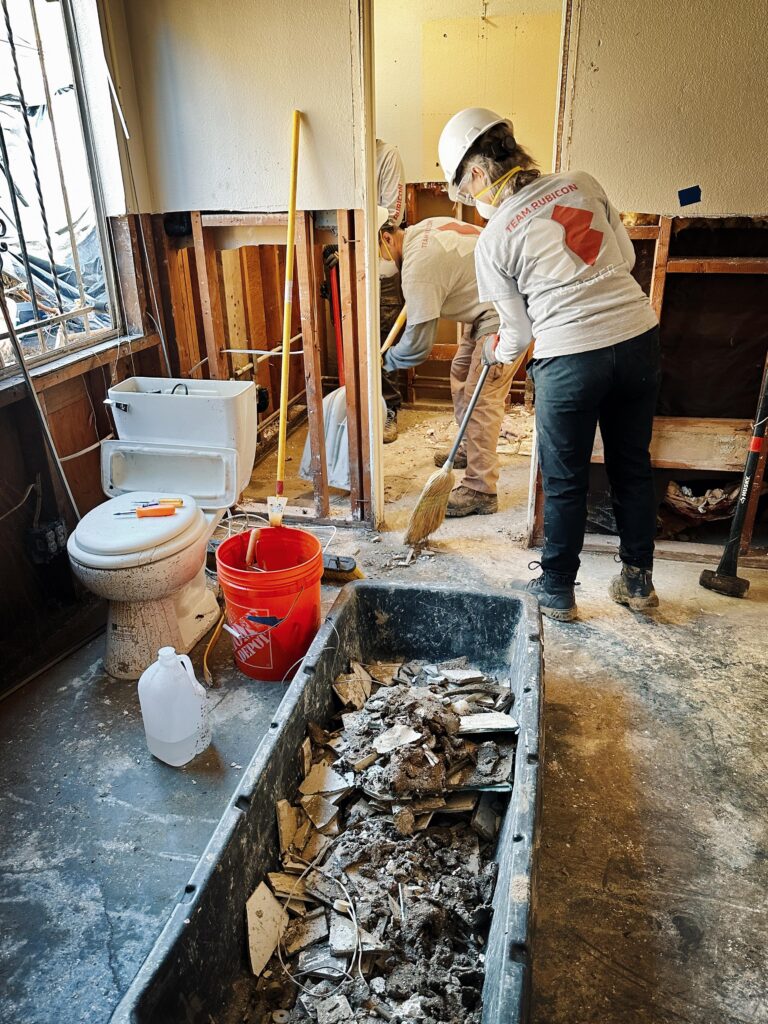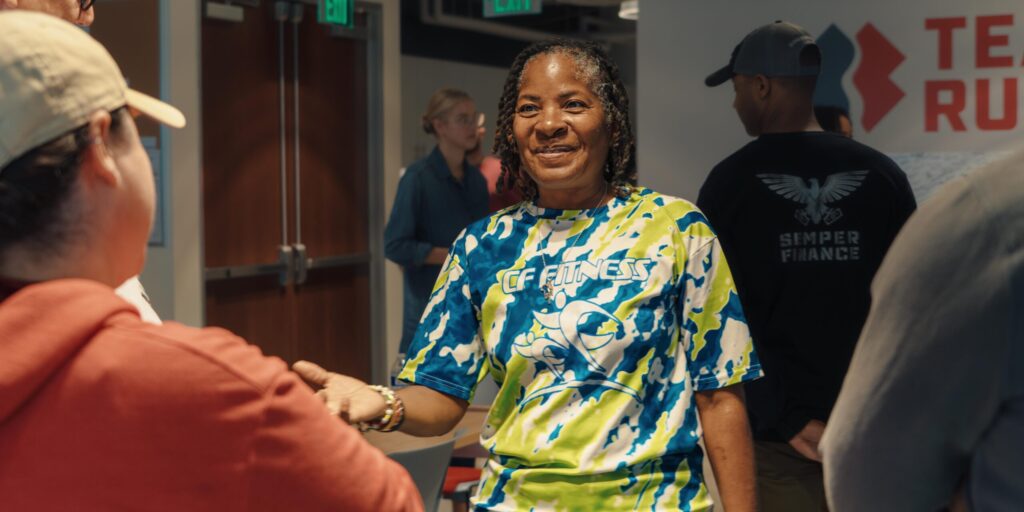The Sims, an American family living in Los Angeles, experienced some of the worst of America, moving from Dust Bowl Oklahoma to post-War California during the height of America’s 20th-century racism. Decades later, when a crew of Team Rubicon Greyshirt volunteers arrived to help Mrs. Floy Ann Sims after a torrential downpour and mudslide that severely damaged her family home, they met some of the best of America.
A Family of Okies Heads West
Floy Ann Sims, a retired teacher and one of eight children, was born in Oklahoma at the outset of World War II. Her father supported the war effort by working in a munitions factory. As a Black man, he was forced to work in the most dangerous, literally explosive, conditions of the factory. Her eldest brother forged his father’s signature at age 15 in order to enter the military and serve in the war.
America in the 1940s was at the cusp of momentous change. A baby boom and economic miracle would soon sweep the nation, as a movement for Civil Rights would transform it. Living in Oklahoma, just 20 years after the Tulsa Race Massacre—the largest and perhaps most devastating racist attack in America during the last century—the Sims could not wait for that transformation.
“My father grew up here, under the Jim Crow laws,” said Floy. “He knew that he would not be able to tolerate how they were treating our people.”

The Sims lived in a “sundown town,” where Black residents risked their lives simply by venturing outside after dark—a regular hazard for her father, a centerfield player with a Negro League baseball team who often had to stay out late for games. The town was segregated, as was the school system, and there was a deep and intractable division between whites and Blacks, as well as routine violence by the former against the latter. Floy’s father was determined to shield his family from the racist culture dominating Oklahoma. So, when an opportunity for employment in Los Angeles presented itself, her father took it and moved out West as soon as he could. His wife and children would join him later, staying with relatives until they could secure a proper home together in LA.
In a New State, Finding Community and Celebrating Juneteenth
California may have been a free state, with no history of chattel slavery, but it was still America before Brown v. Board of Education, Loving v. Virginia, and the 1965 Voting Rights Act. It was an America struggling to live up to its promise, where many Americans were determined to keep the Sims from touching that promise: People the Sims would repeatedly encounter, even in the Golden State.
“Because my brother was a veteran, we were able to stay in Basilone Homes, a military housing facility,” said Floy. It was an integrated installation; white and Black families alike were able to live there but LA was still cold to people like her. “We would take day trips to Val Verde, it’s where all the Black folk from LA would go. We would drive out for the big celebrations, like Juneteenth.”
Celebrating Juneteenth was a custom among America’s Black communities for more than a century before it was authorized as a national holiday in 2021. “We celebrate it because it was a delayed liberation day,” explained Apryl Sims, Floy’s daughter.
Juneteenth commemorates the day when the last enslaved people in America were told they had been freed, two and a half years after the fact. The Emancipation Declaration had gone into effect on January 1, 1863, but it could not be enforced until the Civil War was won. After the war, 2,000 Union troops marched into Galveston, Texas, where more than a quarter million African Americans were still held in bondage. On June 19th, 1865, their delayed liberation had at last arrived. America’s original sin would only finally end six months later, with the ratification of the 13th Amendment to the Constitution.
A century on from Juneteenth, African Americans had an unfortunate need for a place like Val Verde. It was known as the Black Palm Springs, a haven for Black people.
“It was like the meeting spot for African Americans,” recalled Apryl. “These were safe spaces where Black people owned property and could celebrate without being molested by people who didn’t like seeing us celebrate anything.”
Storms of Many Kinds Come for the Family Home
If inside enclaves like Val Verde things were better, in much of California prejudices remained. Many Californians didn’t like seeing people like the Sims owning anything either—especially homes near them. Even into the 1970s, when Larry and Floy Sims began building the Baldwin Hills home Apryl grew up in, the Sims faced obstacles only certain homeowners would.

“We were not welcomed into the community at first,’” said Floy. “My husband, Larry, had lumber stolen from our lot. He had to sleep in the truck on the property to guard his construction materials. He did that until they finished framing the house.”
Larry Sims applied for loans to build his home, but the bank found a reason to consider him a credit risk. Ultimately, a Black-owned bank issued them a loan, and friends and family helped construct their house in Baldwin Hills. From the lot they chose, they could see the Hollywood sign and the famous Griffith Observatory.
“That was our view, and we wanted to take advantage of it. We wanted to capture that view,” said Floy. “And wouldn’t you know it, after my husband installed these big picture windows, somebody smashed them.”
In addition to months of harassment, theft, and vandalism, somebody called the police on Larry. The Sims’ new neighbors discovered that the Black man building the home in their neighborhood was the actual homeowner, not a mere laborer. It did not improve their attitudes towards Larry and his wife.
“In spite of them,” said Floy, “we built our home.”
Some 50 years later, that home was damaged when a large storm crashed into Southern California. Theirs was one of more than a dozen impacted by the 562 mudslides that Los Angeles experienced in the early February 2024 storm.
“I heard something hit the house. It was literally about 3 feet of mud,” said Apryl. “And I knew that was only the beginning because it was still raining and predicted to rain for another several days.”
Because more than four decades years earlier the two women had stood at those big picture windows and watched a house slide down the hill opposite theirs during a bout of heavy rain and mud, they understood the dangers.
“I turned to my mom and told her we have 10 minutes to get out of here,” said Apryl. After taking her mother to a friend’s house, Apryl opened a phone app for the home’s rear door camera and they watched the damage accumulate.
Mud, Muck Outs, and Faith Restored
When the skies cleared, the questions of what to do next and how to recover and rebuild began.
As the women pondered the questions of recovery, Floy’s grandchildren went behind their backs and reached out to Team Rubicon to ask for help.

“We’re proud people,” explained Apryl Sims. “We’re not ones to ask for help. And, sometimes, I thought I was done with America. Done with the hypocrisy, done with the hate.”
One day, Greyshirts appeared at their door.
“This was weeks afterward,” said Floy. “Nobody had come to help. None of the organizations that we thought were there to help us contacted us. We had nobody but Team Rubicon. You all showed up.”
The Greyshirts showed up with hardhats, shovels, and sleds to muck and clean, and to restore a sense of normalcy.
“I saw America show up. The whole rainbow,” said Apryl. “Men, women, black, white, tattoos, red-blooded Americans, people who came from all walks of life—to help us. It was priceless. I needed to see that.”
For two days, local Greyshirts worked on the Sims’ home. They cleared mud, stripped out contaminated sheetrock, and hustled with an organized fury that impressed the Sims. “It was like a beehive,” said Floy. “A swarm of workers who knew what they were doing.”

As they left, the service project leader, Noel Middleton, left a short, 15-word handwritten note for the Sims. “Here is your key. We hope we got you on the path…Blessings, Team Rubicon.” It left an impression so deep that when the repairs to her home are complete, Floy is planning on framing the note right into her wall.
“We walk with purpose is what I used to tell my students,” Floy said. “And Team Rubicon is about purpose. An example of teamwork, for real. The best example I’ve ever seen.” Today, Apryl Sims proudly wears a Team Rubicon bracelet every day. “You all showing up, in your grey shirts. Asking for nothing. It restored my faith in this country,” she said. “It restored my faith in America.”



